Published in the October 13, 2017 edition.
By MARK SARDELLA
WAKEFIELD — If you go by social media, you might conclude that there has been an explosion in the coyote population in and around Wakefield.
Not so, says Ken Stache, Wakefield’s Animal Control Officer for the last 30 years.
“In all the years that I’ve been doing this job, I have not seen an increase in the population of coyotes,” Stache said. Although any animal population can experience a little spurt in numbers, Stache added, “Over the years I have not seen a drastic increase in reports or in the number of encounters people have with coyotes.”
What seems like an increase in coyote sightings is likely in part a function of social media, according to Stache. If someone posts a sighting of a coyote near Four Corners and a while later someone reports seeing one in Forest Glade Cemetery and then some time after that, one is spotted near the Prime Gas Station on Lowell Street, it sounds like a lot of coyote sightings.
“Most likely it’s the same coyote,” Stache said.
Stache said that coyotes tend not to be a threat to humans.
“People ask if are they dangerous to us,” Stache said. “They’re certainly going to view your small pet as a meal. But statistics do not show Eastern coyotes or coywolves as dangerous to humans. There have been only five coyote attacks on humans in Massachusetts since the 1950s. It is a fraction of the number of dog attacks on humans in that same period. The reality is you are more likely to get injured by your own animal then a coyote. About 2 percent of the United States population are bitten by dogs each year.”
Stache pointed out that of those five documented cases of coyote attacks on humans, three of the animals were found to be sick or rabid and the remaining two were cases where people had been feeding them and got too close.
“In Wakefield, I’ve never had one report of people attacked by a coyote,” Stache said. “You are more likely to have an issue with a racoon. Coyotes don’t want to have anything to do with humans. They’d rather not have any interaction at all.”
He pointed out that coyotes will expand their territories in search of food and they will go after pets such as cats or small dogs.
“If they get the opportunity to take a cat,” he said. “They’ll take it. When people are losing their pets, like cats that have never been found and there are no clues to what happened to them, it’s a good possibility it was a coyote or a fox.
“I can’t tell you how many lost cat reports I get in a week,” he said. “You’ve got to keep them indoors. Don’t let them out. If you have a small dog, don’t let it out unattended.”
While coyotes have a negative image with many people, Stache says it’s not that simple.
“Coyotes actually serve a great purpose,” he said. “They control the rodent population. They keep other populations in check that can be more detrimental, like squirrels, chipmunks mice and rats that tend to want to take over your home.”
Even in the case of rabbits, which people see as cute and cuddly, Stache observed, their population can explode out of control without natural predators like coyotes to keep things in check.
The coyote population may not have changed, but their habitat has, Stache said, thanks to humans and development. He cited large developments like the one around the former Our Lady of Nazareth School on the West Side.
“Their hunting area has been taken away,” he said. He noted that coyotes will keep breeding at the same rate even as we take over more space for development. “If we squeeze them they are not going to stop breeding,” he added.
“Those who talk about a coyote in their backyard,” Stache said, “actually built a home in the coyote’s backyard. We created it but we’re not willing to live with it.”
Moreover, people can inadvertently attract coyotes through activities like feeding birds.
“Birds and squirrels are attracted to the bird food,” Stache pointed out, “and coyotes are attracted to the squirrels and birds.”
Stache said that people should take common sense precautions but not overreact to coyotes. “It sounds like everybody’s starting to panic,” he observed.
“People with good reason should be concerned and with good reason should be cautious,” he said. “People who have pets, especially cats, should keep them indoors. You’ve got to be smart about it.”
He noted that coyotes are protected and the Division of Fisheries and Wildlife will not allow the relocation or the euthanizing of a coyote except in extreme circumstances.
“It’s hard to tell people that you need to coexist with them,” he said, “because they are not going to go away.”
Stache said that he’s had the opportunity to learn a lot about coyotes over his years as Animal Control Office.
“I respect them a great deal,” he said.




